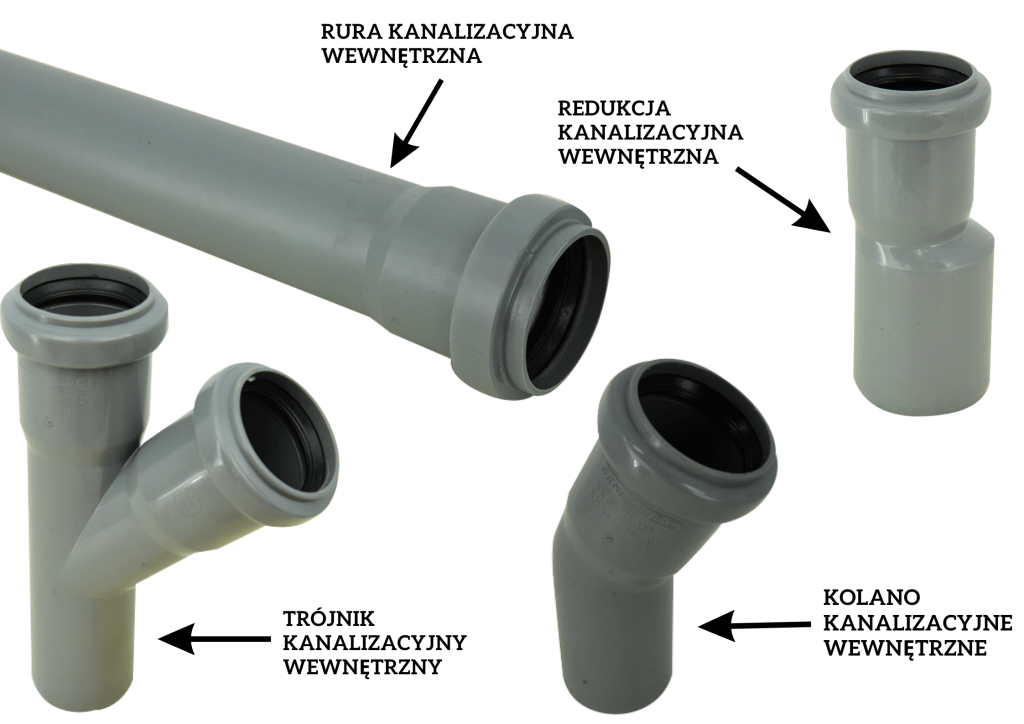Kanalizacja wewnętrzna jest niezbędna do odprowadzenia zużytej wody i nieczystości z budynku. Jej wykonanie jest jednym z ważniejszych etapów budowy domu. Powinna być niezawodna, szczelna i bezawaryjna.
Instalacja kanalizacyjna w domu.
Jak wiadomo, obowiązkowym elementem każdego budynku mieszkalnego jest instalacja wodno-kanalizacyjna. Trudno jest sobie wyobrazić dom, mieszkanie czy biuro bez dostępu do bieżącej wody, która dociera tam właśnie dzięki instalacji wodnej. Zużytą wodę oraz ścieki należy odprowadzić za pomocą kanalizacji. Aby jednak usuwanie ścieków domowych przebiegało sprawnie, to sama instalacja kanalizacyjna musi pracować niezawodnie i bezproblemowo.
Elementy kanalizacji wewnętrznej.
Podstawowymi elementami kanalizacji wewnętrznej są rury oraz różnego rodzaju kształtki takie jak: trójniki, kolanka, redukcje, korki oraz zaślepki. Są one niezbędne do stworzenia kanalizacyjnego. W naszej ofercie znajdują się też czyszczaki, które służą do inspekcji wewnątrz sieci kanalizacyjnej oraz napowietrzacze zapewniające poprawny przepływ ścieków, w układach, gdzie niemożliwe jest zastosowanie wywiewek na pionach kanalizacyjnych. Elementem łączącym instalację kanalizacyjną z urządzeniem sanitarnym jest syfon, zapobiegający przedostawaniu się nieprzyjemnych zapachów.
Kanalizacja wewnętrzna – rodzaje wykorzystywanych rur.
Najczęstszym wyborem instalatorów są rury wykonane z polipropylenu (PP) lub polichlorku winylu (PVC). Właśnie polipropylen (PP) jest jednym z najpopularniejszych tworzyw stosowanych w kanalizacji. Rury te są odporne na związki chemiczne używane w gospodarstwach domowych oraz dość wysoką temperaturę, która w zależności od rodzaju rur nie powinna przekraczać 60°C, a jeśli mają podwyższoną odporność termiczną- nawet do 95°C. Są one tanie, lekkie, nie korodują, a także są odporne na osiadanie osadów. Do łączenia rur stosuje się różnego rodzaju kształtki, posiadające uszczelki zapewniające szczelność układu. Ważne, aby decydując się na tego typu system kanalizacyjny montować go zawsze według zaleceń producenta.
Zalety rur kanalizacyjnych PP.
- posiadają bardzo dobre parametry hydrauliczne
- są lekkie
- montuje się je łatwo i szybko
- są odporne na niszczące działanie ścieków bytowo-gospodarczych
- nie ulegają korozji
- posiadają różnorodne rozmiary i kształty
Średnice rur kanalizacyjnych wewnętrznych.
Standardowe rozmiary średnic rur oraz kształtek kanalizacyjnych wewnętrznych to; 32 mm, 40 mm, 50 mm, 75mm i 110mm. Optymalną wielkość rur kanalizacyjnych obliczamy przez szacunkową ilość ścieków przepływających przez rurociąg zależna od typu przyborów podłączonych do odpływu kanalizacji. Jednak zasada jest taka, że podejście pod pojedyncze urządzenie sanitarne musi mieć średnicę przynajmniej, taką jak jego wylot. Natomiast podejścia, które zbierają ścieki z kilku urządzeń, muszą mieć średnicę co najmniej, taką jak największy odpływ. W systemach kanalizacyjnych wykonanych z PP istnieje możliwość łączenia elementów o różnych średnicach. Do przejścia z mniejszego rozmiaru rur na większy służą redukcje kanalizacyjne lub trójniki redukcyjne dostępne w naszej ofercie.
Rodzaje kształtek do kanalizacji wewnętrznej.
Oprócz redukcji kanalizacyjnych w naszej ofercie dostępna jest cała gama kształtek o różnych średnicach, przydatnych do stworzenia układu kanalizacji:
- kolano kanalizacyjne –aby zmienić kierunek budowanego rurociągu, należy zamontować kolano kanalizacyjne o odpowiednim kącie.
- trójnik, czwórnik kanalizacyjny- służą do łączenia ze sobą kolejnych nitek układu. Zarówno kolana jak i trójniki umożliwiają łączenie rur pod różnym katem.
- korek- przeznaczony jest do zaślepiana kielicha rury kanalizacyjnej.

Kanalizacja wewnętrzna niskoszumowa – sposób na hałas w rurach.
Jeżeli zależy nam na możliwie najcichszym przepływie ścieków, możemy zastosować elementy kanalizacji niskoszumowej, o której pisaliśmy tutaj. System ten umożliwia zredukowanie hałasu do minimum. W Polsce nie ma obowiązku stosowania kanalizacji niskoszumowej, jednak za stosowaniem tego typu rozwiązania przemawia wyższy komfort użytkowania. Kanalizacja niskoszumowa jest szczególnie wskazana w obiektach takich jak hotele, apartamentowce czy wysokie budynki biurowe. Dostępne w naszej ofercie rury niskoszumowe zostały wyprodukowane z materiałów dźwiękochłonnych, ograniczających przekazywanie fal dźwiękowych na inne elementy budynku. Chociaż kanalizacja niskoszumowa zapewni większy komfort akustyczny od standardowej, to musimy pamiętać o jej prawidłowym montażu. Szczególną uwagę należy zwrócić na dobór obejm montażowych, które w takich układach mają za zadanie minimalizować ilość wibracji przekazywanych z powierzchni rury na elementy konstrukcyjne budynku.
Gdzie trafiają usunięte nieczystości?
Gdy ścieki sanitarne zostaną zebrane przez kanalizację wewnętrzną z całego budynku, wówczas trafiają do:
- sieci kanalizacyjnej zewnętrznej,
- przydomowej oczyszczalni ścieków
- szamba, którego budowa jest niezbędna, gdy gmina nie gwarantuje dostępu do sieci kanalizacyjnej.
Kanalizacja wewnętrzna – Jak o nią dbać?
Aby zapobiec awarii systemu sieci kanalizacyjnej, należy w odpowiedni sposób o niego dbać. Niektóre z substancji gromadzących się w instalacji kanalizacyjnej będą negatywnie na niego wpływać, często tworząc zatory. Regularne serwisowanie może skutecznie przed tym chronić.

Pamiętaj!
Nie wrzucaj do kanalizacji nieodpowiednich odpadów, które mogą zapchać cały system kanalizacji. Zużyte chusteczki higieniczne, resztki jedzenia oraz substancje oleiste najlepiej zutylizować wyrzucając je do śmieci. Na odpływie prysznicowym warto zamontować specjalną siatkę, chroniącą kanalizację przed przedostaniem się włosów. W razie niedrożności należy użyć specjalnego płynu przeczyszczającego rury. Jeżeli nie to nie pomoże, konieczna będzie wizyta hydraulika. W miejscach gdzie może występować niska temperatura otoczenia układ kanalizacyjny warto też zabezpieczyć przed mrozem otuliną z materiałów izolacyjnych.
Najczęstsze błędy popełniane przy montażu kanalizacji wewnętrznej:
- dobór nieodpowiednich średnic rur
- niewłaściwe spadki oraz kąty rur
- niesprawne syfony lub ich brak
- niewłaściwie połączone rury
- przy braku poprawnej wentylacji układu może wystąpić w nim podciśnienie wyciągające wodę z syfonów, co sprawia, że przestają spełniać swoje zadanie
Więcej informacji na ten temat zamieściliśmy w innym naszym artykule.
Podsumowanie
Instalacja kanalizacyjna jest niezbędnym elementem każdego budynku. Ma ona za zadanie blokowanie nieprzyjemnych zapachów oraz hałasu związanego z odprowadzeniem ścieków. Dlatego warto zadbać o prawidłowy montaż, jak i wysokiej jakości produkty użyte do stworzenia sieci kanalizacyjnej.
